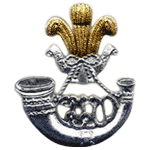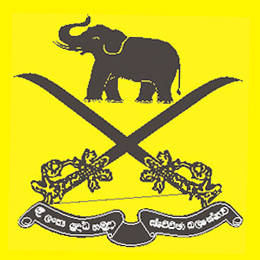Ceylon Defence Force (CDF) was established in 1910 by the Ceylonese legislation Ceylon Defence Force Ordinance, which reformed the Ceylon Volunteer Force (CVF) that existed previously as the military reserve in the British Crown colony of Ceylon. At the time of forming it was only a reserve force but soon developed into a regular force responsible for the defence of Ceylon. The CDF was under the command of the General Officer Commanding, Ceylon of the British Army in Ceylon if mobilised. However mobilisation could be carried out only under orders from the Governor.
General Ranjan Wijeratne was a Sri Lankan planter and politician. He served in the Premadasa cabinet as Minister of Foreign Affairs and then Minister of Plantation Industries, while holding the office of State Minister for Defence.

Captain Samarakoon Wasala Mudiyanselage Saliya Upul Aladeniya, PWV, SLRS was a Sri Lankan soldier and the second recipient of the Parama Weera Vibhushanaya, highest war time award for valor of Sri Lanka. He was commanding the small army detachment at Kokavil, when it was surrounded he refused to abandon the injured and fought until they were overrun by LTTE.

The Sri Lanka Light Infantry (SLLI) is the oldest regiment in the Sri Lanka Army and the oldest infantry regiment in the army. It is made up of ten regular battalions and five volunteer battalions, and is headquartered at the Panagoda Cantonment, Panagoda. Over the years it has become the most distinguished and dependable regiment in the army.

The Sri Lanka Sinha Regiment (SLSR) is an infantry regiment of the Sri Lanka Army; it is the second oldest infantry regiment in the army. It is made up of seven regular battalions, five volunteer battalions and a headquarters battalion at the Ambepussa Camp.
The Gemunu Watch (GW) is a infantry regiment of the Sri Lanka Army, formed with troops from the Ceylon Light Infantry and the Ceylon Sinha Regiment in 1962. It has been deployed in many major operations against the LTTE. It is made up of 14 regular units and 9 volunteer units. Headquartered at Kuruwita Army Camp, Ratnapura. It is named after one of the most famous Lankan Kings, King Dutugemunu.

The Sri Lanka Army Volunteer Force (SLAVF) is the principal and volunteer reserve force component of the Sri Lanka Army. It is a collective name for the reserve units and the Sri Lanka National Guard. The SLAVF is made up of part-time officers and soldiers. They are paid at a similar rate, while engaged on military activities, as their regular equivalents. This is in contrast to the Regular Army Reserve, which comprises people who have a mobilization obligation following their service in the regular army. Administration and recruitment of reserve personal is carried out by the Volunteer Force Headquarters in Shalawa, Kosgama. The head of the SLAVF is the Commandant of the Volunteer Force.
The Ceylon Planters Rifle Corps was a regiment of the Ceylon Defence Force, which existed between 1900 and 1949. It was a volunteer (reserve) regiment based in Kandy, made up of only Europeans that were tea and rubber planters of the hills of Sri Lanka. The regiment deployed personnel to fight in the Second Boer War, the First, and Second World Wars.
The Sri Lanka Rifle Corps (SLRC) is a (reserve) regiment of the Sri Lanka Army. It is made up of two volunteer (reserve) battalions. It has been formed with personnel from the central highlands and the many plantations in the Central Province of Sri Lanka. It is the only regiment of the Sri Lanka Army that recruits its personnel from a particular geographical area.
The Rajarata Rifles was a former rifle regiment of the Sri Lanka Army. It was one of only three geographically based regiments in the Sri Lanka army. The cap badge of the Raja Rata Rifles show the figure of a Bherunda Pakshiya.

Major General Anton M. Muttukumaru, OBE, ED, ADC, idc was the first Ceylonese Army officer to serve as Commander of the Ceylon Army, a post he held from 1955 to 1959. He also served as Ceylon's High Commissioner to Australia, New Zealand, Pakistan and Ambassador to Egypt.

Major Edward Alexander Nugawela was a Sri Lankan lawyer and politician. He was the first Cabinet Minister of Education in independent Sri Lanka (1947–1954), later Cabinet Minister of Health (1954–1956), a Member of Parliament and State Council.
Major General Deshamanya Alexander Richard Udugama, MBE was a Sri Lankan military leader, politician and diplomat. Former Army Commander (1964–1966), he was elected as Member of Parliament for Matale from 1970 to 1977 and served as Sri Lankan Ambassador to Iraq from 1979 to 1982. He was accused of an alleged coup d'état in 1966.
Major General Gemunu Kulatunge, RSP, USP, ndc, psc (1941-2003) was a Sri Lankan general, who was the former Deputy Chief of Staff of the Sri Lanka Army.

General Anuruddha Leuke Ratwatte, frequently referred to as Anuruddha Ratwatte, was a Sri Lankan soldier and politician. He was a Cabinet Minister and Deputy Minister of Defence.

Colonel Candauda Arachchige Dharmapala, OBE, ED was Sri Lankan politician. He was a Parliamentary Secretary to the Minister of Industries, Housing and Social Services and Member of Parliament for Hakmana. He also served as the permanent secretary to the Ministry of Defence, and as Security Adviser to President J. R. Jayewardene.
Lieutenant General Henry Vijaya Athukorale, VSV, psc, FBIM was a Sri Lankan general. He served as Commandant, Volunteer Force and Commander, Task Force Anti Illicit Immigration.
Colonel Sooriyaratne Douglas Ratwatte, ED was a Sri Lankan army officer. He was the Commandant of the Volunteer Force.
Brigadier Roy Douglas Jayetileke, MBE was a Sri Lankan military leader. He served as the first Commandant of the Army Recruit Training Depot and founding commanding officer of the Sri Lanka Sinha Regiment.
Colonel Alan Tollence Nugawela (19??-2007) was a Sri Lankan army officer and a planter.







